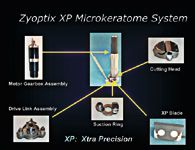Article
Study confirms predictability of microkeratome
Author(s):
London-Results of a study evaluating a recently released microkeratome (Zyoptix XP, Bausch & Lomb) indicate it is a reliable instrument for predictable flap creation, reported Jay S. Pepose, MD, PhD, at the XXIV Congress of the European Society of Cataract and Refractive Surgeons.

The study was performed at the Pepose Vision Institute, St. Louis, MO, where Dr. Pepose is medical director. It prospectively evaluated flap outcomes in 75 eyes that underwent flap creation with the new microkeratome and compared the results with a group of historical controls operated on with another microkeratome (Hansatome Excellus, (Bausch & Lomb) that were matched for mean keratometry, central corneal thickness, spherical equivalent, age, microkeratome head depth, and suction ring size (8.5 mm and 9.5 mm).
Forty-one eyes underwent flap creation using the 120-µm plate of the Zyoptix XP and were compared with 41 eyes operated on with the 160-µm plate of the Hansatome. In 34 eyes, the 140-µm plate of the Zyoptix XP was used for flap creation, and their outcomes were compared against those achieved in 34 eyes operated on with the 180-µm plate of the Hansatome. Dr. Pepose performed all of the surgeries.
The results showed that, compared with the Hansatome, flaps created with the Zyoptix XP microkeratome were similar in mean thickness. The Zyoptix XP flap groups, however, had significantly less thickness variability, had a mean thickness closer to the nominal labeling, and were less likely to be influenced by variations in preoperative ocular parameters.
"When performing LASIK, various studies support the advantages of being able to create a thin lamellar flap with consistently low variation in thickness," said Dr. Pepose, who is also professor of clinical ophthalmology, Washington University School of Medicine, St. Louis, MO.

Overall, the patients included in the study had a mean age of about 40 years, a mean preoperative SE of about –3.5 D, and mean central corneal thickness of about 555 µm.
No significant differences in any of these parameters existed when comparing the eyes treated with the Zyoptix XP 120-µm plate and the eyes treated with the Hansatome 160-µm plate or in comparisons between the two thicker-flap groups. Mean K was almost identical in the two thinner-flap groups, although there was a trend for the corneas to be steeper in the Hansatome 180-µm group compared with the Zyoptix XP 140-µm group (44.20 versus 43.69 D), according to Dr. Pepose.
Flap thickness was determined by subtraction based on an average of three ultrasound pachymetry measurements obtained before and after flap creation. No significant differences were seen in mean thickness comparing the various groups in the study. Mean flap thicknesses were 126.5 µm for the Zyoptix XP 120-µm group, 128.9 µm for the Hansatome 160-µm group, 143.7 µm for the Zyoptix XP 140-µm group, and 143.3 µm for the Hansatome 180-µm group.
Newsletter
Don’t miss out—get Ophthalmology Times updates on the latest clinical advancements and expert interviews, straight to your inbox.




